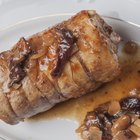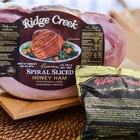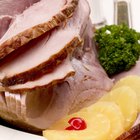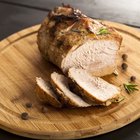SpencerSternberg/iStock/GettyImages
To the uninitiated, ham is ham. It's pink and salty, usually with sweet and smoky overtones as well, and it goes well with just about any side dishes you care to name. A closer look shows that this is a remarkable simplification. There are hundreds of kinds of city hams, country hams, spiral-cut hams and imported dry hams, all with their own distinct characteristics. Spiral-cut hams are among the easiest to understand, being just a city ham that's pre-sliced for convenience.
The Fundamentals of Ham
At bottom, ham is the cured hind leg of a hog. Hams sold in the United States are most offen cured in a wet brine of salt, sugar and spices, and are sometimes referred to as "city hams." They're usually sold cooked and ready to eat. Country hams are cured in a dry salt mixture, then hung to air-dry in a carefully controlled setting. This gives them a dense texture and concentrated flavor, much like imported dry hams such as prosciutto and jamon serrano. They're sold raw and can be shaved thinly like prosciutto or cooked. They must be soaked and simmered long enough to remove the excess salt before they're cooked.
City Ham vs. Spiral-Cut
City hams are sold in several versions, all of which have their merits. Full hams are available, but at an average of 15 pounds they're too large for the typical modern family. They're usually cut into a butt and a shank portion, with the butt yielding larger slices but the shank having denser, more flavorful meat. Some are boneless, while others retain their bones. Spiral-cut hams are made at the processing plant by slicing a bone-in city ham in one continuous spiral, leaving the meat on the bone in its original shape. Rather than carving the ham by hand, the cook must only cut the meat from the bone to have perfect, consistent slices.
Choosing Your Ham
Spiral-cut hams vary widely in quality. Often hams from small, regional producers are superior to their mass-market counterparts. Asking your butcher for advice can be helpful, as can checking the ham's label, which often contains useful information. Hams that are naturally smoked have better flavor than those with smoke flavor added. Checking the ham's water content is important; the best hams contain no added water, and their labels simply describe them as "ham." "Ham with natural juices" is the next-highest grade; a spiral-cut ham labeled as "ham and water" is usually inferior in flavor and texture.
Preparing a Spiral Cut Ham
Spiral-cut hams are fully cooked, so they only require reheating before they're served. You can cut the slices away for sandwiches or breakfast ham or bake the entire ham for a festive meal. If you're preparing the whole ham, it's best to bake it at temperatures of 300 degrees Fahrenheit or lower to keep it from drying out. Bake it in a covered pan or a roasting bag to help retain moisture. If you prefer your hams glazed, uncover the ham or cut open the bag for the last 15 minutes of cooking. Turn your oven up to 425 F while you're glazing the ham, then return the ham to the oven until the glaze is caramelized.
Related Articles

How to Slow-Cook Peameal Bacon

Cooking Instructions for a Ridge Creek ...

How to Carve a Spiral Cut Ham

Instructions for Baking a Smoked Ham ...

How Many Calories Are in Smoked Ham?

How to Steam Cook Bratwurst

How Do I Roast a Picnic Ham?

What Is a Black Forest Ham?

How to Boil Cabbage and Ham

How to Tell If Smoked Ham Hocks Are ...

How to Make Salt Brine

What Is a Chateau Cut?
Directions for Cooking a Picnic Ham ...

How to Bake a Juicy Tender Ham

How to Store Uncooked Smoked Ham

Shank Ham Cooking Directions
How to Cook Buffalo Fillet

Instructions for Baking a Smoked Ham ...

How to Cook a Tavern Ham

What Is Sirloin Roast?
References
Writer Bio
Fred Decker is a trained chef and prolific freelance writer. In previous careers, he sold insurance and mutual funds, and was a longtime retailer. He was educated at Memorial University of Newfoundland and the Northern Alberta Institute of Technology. His articles have appeared on numerous home and garden sites including GoneOutdoors, TheNest and eHow.